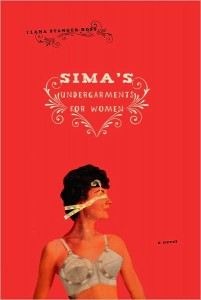 At its core, Sima’s Undergarments for Women (Overlook, 2009) is a love story. Many reviewers of this moving debut novel by Ilana Stanger-Ross note the sensitivity and care the author uses to describe Sima Goldner’s small basement lingerie shop: the neighborhood gossip, the constant trips up and down a stepladder, the dressing room sessions that are equal parts therapy and the quest for the perfect fit. Stanger-Ross (who, incidentally, is studying to be a midwife) has an eye for detail and an ear for humor in conversation. Sima herself is rendered so startlingly real, and with such empathy, that we cannot help but root for her. In the Jewish neighborhood of Boro Park in Brooklyn, Sima and her husband, Lev–both in shuffling middle age–have long accepted (but are forever marked by) the disappointment of not being able to have children. Sima has withdrawn into the world of her shop, away from the shroud of tragedy cast over her marriage. The story begins when a vivacious young Israeli woman, Timna, enters Sima’s shop and changes everything.
At its core, Sima’s Undergarments for Women (Overlook, 2009) is a love story. Many reviewers of this moving debut novel by Ilana Stanger-Ross note the sensitivity and care the author uses to describe Sima Goldner’s small basement lingerie shop: the neighborhood gossip, the constant trips up and down a stepladder, the dressing room sessions that are equal parts therapy and the quest for the perfect fit. Stanger-Ross (who, incidentally, is studying to be a midwife) has an eye for detail and an ear for humor in conversation. Sima herself is rendered so startlingly real, and with such empathy, that we cannot help but root for her. In the Jewish neighborhood of Boro Park in Brooklyn, Sima and her husband, Lev–both in shuffling middle age–have long accepted (but are forever marked by) the disappointment of not being able to have children. Sima has withdrawn into the world of her shop, away from the shroud of tragedy cast over her marriage. The story begins when a vivacious young Israeli woman, Timna, enters Sima’s shop and changes everything.
Stanger-Ross conceives her lonely seamstress masterfully and completely, down to the embarrassment Sima feels when caught staring at Timna’s perfect breasts. As Sima’s obsession with Timna’s lively presence in her life grows, so does the pathos of her longing. A rekindled yearning for motherhood carries Sima through emotions akin to romantic love: fascination, passion, jealousy and revelation. For Sima, Timna is the daughter she wished for, and the fulfillment of dreams she thought died long ago. When Timna comes to work at Sima’s Undergarments for Women, those dreams flourish anew. Sima plans conversations, jokes to tell, all the while storing up Timna’s smiles and intimacies like talismans against unhappiness. Early in Timna’s tenure at the shop, Sima cooks an elaborate Rosh Hashanah meal, and Lev teases her that she cooked for an army. Sima “pressed her nail into her hand to try to check her eagerness and hoped that, with the table so covered in food, it did not look bizarre, desperate.” The truth is, Sima is desperate, but it would be a challenge to find a human being anywhere who had not been there himself.

Ilana Stanger-Ross
One of the many pleasures of Sima’s Undergarments for Women is its intimate scope. In just over 300 pages, Stanger-Ross unfurls Sima’s entire adult life, from newlywed to matron of a successful underwear shop that provides a haven for the women and girls of Boro Park, a social hub of the community. There is boisterous Connie, Sima’s best friend since childhood, who cannot fathom the depth of her friend’s sadness at not being able to conceive. Connie’s husband Art practices law, and harbors secrets of his own. The bras, too, are described in loving detail: “a deep green bra with leaf-embroidered straps and an ivory tulle demi-cup popular with brides” which against Timna’s skin becomes “a lizard asleep on desert sand.” Sima is a master, and passages where she fits clients, or intuits their desires before they know them, hold all the delight of watching an artist at work. Much of the story takes place in the little basement shop, and one sees how rich and complex Sima’s life has been, in spite of her hidden grief.

Boro Park, Brooklyn (2007) / photo by MASCURAK, flickr cc
Timna becomes not only the object of Sima’s affection, but a lens that turns Sima inward, uncovering a secret that she’s concealed from everyone around her, even Lev. A lifetime of keeping her own counsel has stoked Sima’s fear of being left by those she loves. Looking at Timna, Sima longs to give advice: “Let me take care of you, she wanted to say, let me be there for you. The words burned the back of her throat, but she did not let them out.” The contrast between youth and age, between Timna’s life ahead of her, and Sima trundling up the stairs to Lev in his undershirt is one of the underpinnings of the novel. Sima marvels at this difference while still a young woman, riding the train back from another disheartening doctor’s appointment:
How strange she though, as she scanned the subway car, that each one here had once been cooed over, doted on: white ribbons carefully tied beneath their soft chins, scallop-trimmed cotton hats centered on wispy-haired scalps. Each had been a baby like the one she coveted, now grown to mediocrity: this one a mole on her chin with the obligatory curl jutting from it; another a pale belly not quite concealed by a gray oil-stained tee.
Sure, things fall apart, but as Tennyson’s Ulysses says, “something ere the end,/ Some work of noble note, may yet be done”. Sima may not fulfill all of her dreams through Timna, but the presence of the girl reminds the old woman what it is to dream, and what it feels like to tell the truth. Sima contemplates revealing her secret as a kind of warning to headstrong Timna, but fear constrains her.
As terrible as it was to admit her own flawed history, it would be worse still to observe its effect: the disbelief with which the long-ago stories of the old were inevitably met, the pain of watching Timna realize, so you were young once, too.
Sima may not be able to confess all to Timna, but through her love for this young woman, she may yet forgive herself and rebuild her own family.
Extras

Ilana Stanger-Ross signs copies of Sima / photo from Penguin Group (Canada) on flickr
– You can read an excerpt from Sima’s Undergarments for Women via the website She Knows.
– Listen to a podcast interview with Ilana Stanger-Ross at Single Women Rule.
– At the author’s website, read a Q&A with Ilana Stanger-Ross, as well as her blog on Judaism, writing, bras, midwifery, and more.
– View a slideshow of some of the inhabitants of Boro (Borough) Park, Brooklyn, where Sima’s story is set, on the New York Times website.
– Visit Indiebound to order Sima’s Undergarments for Women from any independent bookstore–or locate a local shop where you can pick up a copy.
– Learn more about indie publisher Overlook Press, who published the novel in hardcover. The paperback edition is forthcoming this June from Penguin.





